非谓语动词,现在分词过去分词
- 格式:doc
- 大小:40.00 KB
- 文档页数:4
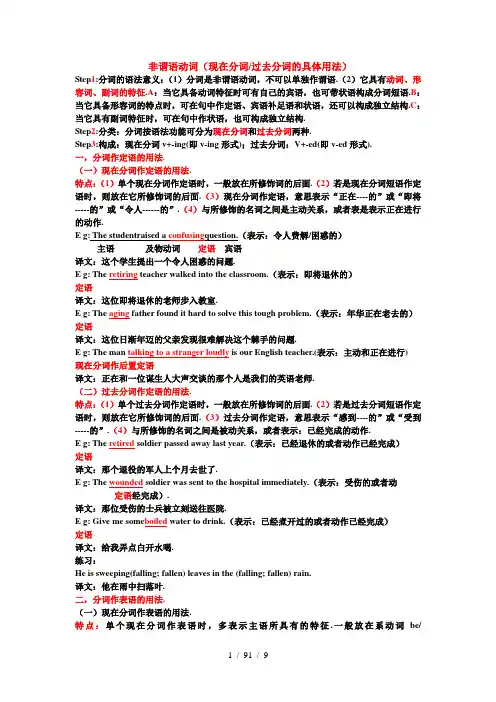
非谓语动词(现在分词/过去分词的具体用法)Step1:分词的语法意义:(1)分词是非谓语动词,不可以单独作谓语.(2)它具有动词、形容词、副词的特征.A:当它具备动词特征时可有自己的宾语,也可带状语构成分词短语.B:当它具备形容词的特点时,可在句中作定语、宾语补足语和状语,还可以构成独立结构.C:当它具有副词特征时,可在句中作状语,也可构成独立结构.Step2:分类:分词按语法功能可分为现在分词和过去分词两种.Step3:构成:现在分词v+-ing(即v-ing形式);过去分词:V+-ed(即v-ed形式).一,分词作定语的用法.(一)现在分词作定语的用法.特点:(1)单个现在分词作定语时,一般放在所修饰词的后面.(2)若是现在分词短语作定语时,则放在它所修饰词的后面.(3)现在分词作定语,意思表示“正在----的”或“即将-----的”或“令人------的”.(4)与所修饰的名词之间是主动关系,或者表是表示正在进行的动作.E g: The studentraised a confusing question.(表示:令人费解/困惑的)主语及物动词定语宾语译文:这个学生提出一个令人困惑的问题.E g: The retiring teacher walked into the classroom.(表示:即将退休的)定语译文:这位即将退休的老师步入教室.E g: The aging father found it hard to solve this tough problem.(表示:年华正在老去的)定语译文:这位日渐年迈的父亲发现很难解决这个棘手的问题.E g: The man talking to a stranger loudly is our English teacher.(表示:主动和正在进行)现在分词作后置定语译文:正在和一位谋生人大声交谈的那个人是我们的英语老师.(二)过去分词作定语的用法.特点:(1)单个过去分词作定语时,一般放在所修饰词的后面.(2)若是过去分词短语作定语时,则放在它所修饰词的后面.(3)过去分词作定语,意思表示“感到----的”或“受到-----的”.(4)与所修饰的名词之间是被动关系,或者表示:已经完成的动作.E g: The retired soldier passed away last year.(表示:已经退休的或者动作已经完成)定语译文:那个退役的军人上个月去世了.E g: The wounded soldier was sent to the hospital immediately.(表示:受伤的或者动定语经完成).译文:那位受伤的士兵被立刻送往医院.E g: Give me some boiled water to drink.(表示:已经煮开过的或者动作已经完成)定语译文:给我弄点白开水喝.练习:He is sweeping(falling; fallen) leaves in the (falling; fallen) rain.译文:他在雨中扫落叶.二,分词作表语的用法.(一)现在分词作表语的用法.特点:单个现在分词作表语时,多表示主语所具有的特征.一般放在系动词be/become/look/sound/smell/remain/seem/appear等后面.作表语的分词均为形容词.可以译成:“-----------的”.E g: The English speech contest is really exciting.(表示:令人兴奋的)表语译文:这次英语演讲比赛很令人兴奋.E g: The naughty baby is very tiring.(表示:令人累的)表语译文:这个调皮的孩子真是累人.E g: The food smells so inviting.(表示:令人诱惑的)表语译文:这食物闻起来很诱人.E g: This once-in-a-blue-moon experience is really thrilling.(表示:令人刺激的)译文:这次难得的经历真扣人心弦.(二)过去分词作表语的用法.特点:单个过去分词作表语时,多表示主语所处的状态.一般放在系动词be/ become/look/sound/smell/remain/seem/appear等后面.作表语的分词均为形容词.可以译成:“-----------的”.E g: I was bored by her endless bragging.(表示:感到枯燥、厌倦的).译文:她不停地吹嘘,我烦透了.E g: I’m really interested in making a speech in English in public.(表示:感到有趣的)译文:我对在公共场合用英文演讲非常感兴趣.E g: I felt confused about this matter.(表示:感到费解、迷惑的)译文:我对这件事情很费解.总结:并非所有的分词均可当形容词对待.有些分词不能翻译成“--------的”.Killed:不能译成“感到杀的”Killing:不能译成“令人杀的”Writing:不能译成“令人写的”Written:不能译成“感到写的”此类分词,只能置于be动词之后,不可置于连系动词(become/look/sound/smell/remain/seem/appear)等后面,不可视为是形容词,而视为动词的进行时或被动语态.E g: He was murdered last night.(表示:一般过去式的被动语态)译文:他昨晚被谋杀了.E g: I can’t believe you didn’t have a written contract.译文:我简直不敢相信,你居然没有一份书面合同.三,分词作宾语补足语的用法.(一)现在分词作宾语补足语的用法.特点:现在分词作宾语补足语时常用在感官动词和使役动词之后,现在分词一般强调动作正在进行,主动,与物有关.方法:(1)宾补的动词若为及物动词,后面一定接宾语,共同作宾补.(2)宾补的动词为不及物动词,一律用现在分词.(3)宾语与宾补之间为主动关系.(4)宾补的动作在逻辑上是由宾语来完成的.E g: I heard some girls gossiping about you.宾语补足语译文:我听到一些女孩子在说你的闲话.E g: I found him killing cockroaches宾语补足语译文:我发现他正在杀蟑螂.E g: I saw him coming out of the office just now.宾语补足语译文:我刚才看见他正在从办公室出来.(二)过去分词作宾语补足语的用法.特点:现在分词作宾语补足语时常用在感官动词和使役动词之后,过去分词一般强调被动,完成,与人有关.方法:(1)宾补的动词为及物动词,后面不可接宾语(2.)宾语与宾补之间为被动关系,宾补与前面的宾语构成动宾关系.(3)宾补的动作不是由宾语自身完成.E g: I found the cockroaches killed.(过去分词充当宾语补足语)译文:我发现那些蟑螂被人杀了.E g: I had my wallet robbed in the street this morning.(过去分词充当宾语补足语)译文:今天早上在街上我的钱包被人抢了.(三)由介词with引导的复合结构中,分词作宾语补足语的用法.特点:置于句首或句尾,常用来修饰句中的主语,以表示主语所处的状况,通常为大动作附带小动作时,大动作以句子的动词表示,而小动作则使用with复合结构.(1)with +宾语+宾补(过去分词充当).特点:宾语与宾补之间表示被动和完成.E g: He stood there with his arms folded.译文:他双臂交叉站在那里.E g: He sat there with his eyes closed.译文:他双眼闭着坐在那儿.(2)with +宾语+宾补(现在分词充当).特点:宾语与宾补之间表示主动和正在进行.E g: He talked to me with his legs shaking译文:他和我说话时两腿发抖.E g: A: Come on, Please give me some ideas about the project.B: Sorry. With so much work filling my mind, I almost break down.(3)with +宾语+宾补(动词不定式充当).特点:宾语与宾补之间表示将要发生或没有完成.E g: With a lot of difficult problems to settle, the manager felt worried all the time.译文:由于很多的难题没有得到解决,经理一直很担忧.(4)with +宾语+宾补(介词短语充当).特点:表示宾语所处的状态.E g: He talked to me with a pipe in his mouth.译文:他和我说话时嘴里叼着烟斗.四,分词作状语的用法.(一)现在分词作状语的用法.特点:(1)现在分词短语作状语时刻表示原因、方式、伴随、结果、或条件等.此时它的逻辑主语应与句子的主语保持一致.(2)现在分词一般式,若现在分词短语表示的动作与谓语表示的动作同时发生,或者紧接发生,也可在该短语前加上when或while; (3)现在分词的完成时,若现在分词短语表示的动作在谓语表示的动作之前发生.(4)若现在分词短语的逻辑主语(即句子的主语)发出该动作,则就是主动语态.(5)若现在分词短语的逻辑主语(句子的主语)承受了该动作,那么就用它的被动式.E g:We often provide our children with toys, footballs or basketballs,thinking that all children like these things.(现在分词在句中作伴随状语,而且句子的主语是thinking的执行者).译文:我们考虑到孩子们都喜欢这些东西,通常给孩子提供玩具;足球和篮球.E g: Daddy didn’t mind what we were doing, as long as we were together, having fun.(现在分词在句中作伴随状语,而且句子的主语we是having的执行者).译文:只要我们能在一起共享乐趣,爸爸不会介意我们在做什么.E g: The storm left, having caused a lot of damage to this area.(说明:分词的逻辑主语为the storm,故用现在分词表示主动,因为是造成破坏之后离开的,所以用现在完成时态,在句中作时间状语从句)可以改写为:After it had caused a lot of damage to this area, the storm left.E g:Having been separated from other continents for millions of years, Australia has many plants and animals not found in any other country in the world.(说明:separate from 与主句主语有被动的含义,并且先于主句谓语动词,因此用现在分词完成时的被动语态)E g: Oil prices have risen by 32percent since the start of the year, reaching a recor d$57.65 a barrel on April 4.(现在分词在句中作伴随状语)译文:自从今年开始油价已经上涨了32﹪,在4月份达到每桶$57.65这个记录.E g: The manager, having made it clear to us that he didn’t agree with us, left the meeting room.(现在分词的完成时态表示动作发生在主句的动作之前).E g: Whenever he was asked why he was late for class, he would answer careless, always saying the same thing.译文:无论什么时候他被问到为什么他会上课迟到,他总是粗心地答复,说着同样的话.E g:He is a student at OxfordUniversity, studying for a degree in computer science.(现在分词在句中作伴随状语)E g: He was busy writing a story,only stopping once in a while to smoke a cigarette.(现在分词在句中作伴随状语)译文:他那时忙于写一个故事,只是偶尔停下来抽支烟.E g:Having been shown around the Water Cube, we were then taken to see the Bird’s Nest for the 2008 Olympic Games.译文:我们参观了水立方后,又被带去参观了为20XX年奥运会准备的鸟巢.E g: Not realizing that he was in great danger, Eric walked deeper into the forest. (主语Eric与realize 构成主动关系,因此用realizing,v-ing形式前加not表示否定)练习题:1,in the queue for half an hour, the old man suddenly realized he had left the cheque in the car.A: Waiting B: To wait C: Having waited D: To have waited2, in the fields on a March afternoon, he could feel the warmth of spring.A: To walk B: Walking C: Walked D: Having walked3, their hats into the air, the fans of the winning team let out loud shouts of victory.A: To throw B: Thrown C: Throwing B: Being thrown4, We had an anxious couple of weeks for the results of the experiment.A: wait B: to be waiting C: waited D: waiting.5, that she was going off to sleep , I asked if she’s like that little doll on her bed.A: Seeing B: To see C: See D: Seen.6, The wild flowers looked like a soft orange blanketthe desert.A: Covering B: Covered C: Cover D: To cover.(二)过去分词作状语的用法.特点:(1)过去分词短语作状语修饰谓语动词,说明其发生的情况,可以放在句首其强调作用,也可放在句中、句末,它的逻辑主语须与句子的主语保持一致.(2)过去分词一般表示动作已完成,只有一般式.(3)过去分词表示被动和完成E g:Dressed in a white uniform, he looks more like a cook than a doctor.说明:当状语从句的主语和主句主语相一致且谓语包含动词be的某种形式时,可省略从句的主语以及动词be. 恢复原句:When he is dressed in a white uniform, -----------.译文:穿着白色的制服,他看上去更像是个厨师而不像医生.E g: When offered help, one often says “ Thank you.”O r“It’s kind of you.”译文:当被提供了帮助时,人们常说:“谢谢”或“你真好”.E g: Faced with so much trouble, we failed to complete the task on time.说明:be faced with 表示:“面临,面对.”作原因状语.译文:由于面临很多的困难,我们未能按时完成这项工作.E g: Blamed for the breakdown of the school computer network, Alice was in low spirits.(作原因状语).练习题:1,No matter how frequently , the works of Beethoven still attract people all over the world.A: Performed B: Performing C: to be performed D: being performed2,The flowers his friend gave him will die unlessevery day.A: watered B: watering C: water D: to water3, by a greater demand of vegetables , farmers have built more green houses.A: Driven B: Being driven C : To drive D: Having driven4, To learn English well, we should find opportunities to hear Englishas much as we can.A: speak B: speaking C: spoken D: to speak5, It is one of the funniest things on the internet so far this year.A: finding B: being found C: to find D: found(三)分词结构-----动词变化1,若一句中有两个动词同时存在,彼此一定要有连接词相连.E g: He studied very hard but failed the exam.2, 若两个动词没有连接词相连,注意下列变化原则.(1) 若两个动词所代表的动作时同时发生时,第二个动词一定要变成现在分词;若该动词是be动词,变成现在分词being 之后要省略.E g: He sat in the corner reading books.(他一面坐在角落,一面看书,动作同时发生,因此read应该变成现在分词)译文:他坐在角落看书.E g: Don’t sit there doing nothing. Come and help me with this table.译文:别坐那儿无所事事,过来帮助我收拾一下桌子.E g: He came home was tired.第一步:变成:He came home being tired.第二步:变成:He came home tired.(说明:他一面回家,一面感到累,故came与was tired同时发生.由于was是be动词,变成being之后应给予省略)译文:他回到家感到很累.E g: He left young and came back old.译文:他少小离家老大回.E g: We are born equal.译文:我们生而平等.(2)若两个动词所代表的动作并非同时发生,而是有先后次序时,第二个动词就要变成“to+动词原形)形成的不定式短语,作目的状语.E g: He stood up to smoke a cigarette.译文:他站起来抽烟.E g: He rushed here to tell me the story.译文:他赶到这里来告诉我这个故事.(3)若有两个动词有逗号隔开,而无连接词时,就不必考虑动词所代表的动作先后发生的次序,第二个动词一定要变成现在分词.E g: He left home at six in the morning, arriving here about four in the afternoon.译文:他早上6点离开家,约下午4点抵达此地.E g: He ran away quickly, looking as if something terrible had happened.译文:他很快的跑开了,看起来好像发生了什么可怕的事.(四)分词结构-----单句化简法.两个句子在一起,若无连接词相连时,往往第一个句子要化简,变成分词短语.法则如下:(1)两句的主语相同时,被化简的句子的主语要删除,若主语不同时要保留.(2)之后的动词要变成现在分词.(3)若该动词为be动词时,变成现在分词being之后,可给予省略,但亦可不予省略,以强调“因为------”的意思.E g: He has nothing to do, he feels bored.改正:化简第一个句子第一步:删除相同的主语he第二步:其后动词has变成现在分词having.最简化为:Having nothing to do , he feels bored.译文:他没有事情可做,所以觉得无聊.E g: He was sick of studying, he ran away from home.改正:化简第一个句子第一步:删除相同的主语he第二步:其后动词was变成现在分词being,然后给予省略.最简化为:Sick of studying, he ran away from home.译文:他厌倦学习,所以离家出走了.E g: The sun set, the cowboys rode back to the ranch.改正:化简第一个句子第一步:因为两个句子的主语不同,故要保留.第二步:其后动词set变成现在分词setting.最简化为:The sun setting, the cowboys rode back to the ranch.译文:夕阳西下,牛仔们刺马回到牧场(五)使用单句化简法时应注意事项.(1)变成否定分词结构时,not要置于分词前.E g:Not satisfied with result, he decided to try again.译文:他不满意此结果,决定再试一次.(2)句中有助动词do/does/did时,可直接删除.E g: He didn’t intend to see her, he left early.-----Not intending to see her, he left early.译文:他不打算见她,便提前离开了.(3)句中有完成时助动词has /have/had要视为动词而变成现在分词having.E g: He had done the work, he felt very happy.--------having done the work , he left happy.译文:他做完了这个工作,觉得很高兴.E g: I have not seen her for ages, I miss her very much.-------Not having seen her for ages, I miss her very much.译文:好久没有见面了,我非常想念她.(4)主语不同时,所形成的分词短语,成为分词的独立主格结构.所谓分词的独立主格结构,就是独立修饰不同主语的分词结构.在句中只能做状语,表示条件;时间;原因;伴随情况.E g: This being the case, you’d better be more careful.(解释:this being the case原为this is the case,但如此一来,本句与you’d better be more careful 无连接词相连.故将第一个句子化简为分词短语.由于主语不同,故给予保留,之后的动词is变成现在分词being, being the case 独立修饰不同主语this,故称为分词的独立主格结构).译文:这样的话,你最好多加小心.E g: All things considered, I decided to major in business administration.译文:全盘考虑后,我决定主修企业管理.E g: All the work finished, you can go home.译文:所有工作都做完了,你可以回家了.E g: Weather permitting , we are going to have a picnic tomorrow.译文:若天气许可,我们明天就去野餐.(六)分词短语------定语从句化简法.1,在限定性定语从句中、(即关系代词之前无逗号)中,若关系代词作主语时,可化简成分词短语,法则如下:(1)删除关系代词(2)其后动词变成现在分词.(3)若该动词为be动词,变成现在分词being之后,可给予省略.E g: The man who is talking to Mary over there is my father.第一步:将who删除第二步:将who之后的is变成现在分词being第三步:再将being省略.上句可简化成:-----------The man talking to Mary over there is my father.译文:那边那位正在和玛丽说话的男士是我爸爸.2,在非限制性的定语从句中(即关系代词之前有逗号)通常不得化简为分词短语.E g: I like Tom, who is talking to Mary.-------不能变成I like Tom, talking to Mary.3, 不过在非限制性的定语从句结构为“关系代词+be+名词”时,则仍可化简,从而形成同位语.E g: John, who is a good friend of mine, studies hard.------John, a good friend of mine , studies hard.译文:约翰,我的一个好朋友,学习很用功.(七)分词短语------状语从句化简法.Once; when; while; if ;unless; though等六个连接词所引导的状语从句中,若主语与主句中的主语相同时,亦可化简为分词结构,法则与单句化简完全相同.注意:once; if; unless所引导的状语从句若化简为分词短语,多限于“主语+be+分词/形容词”的结构;而when; while; though则不限于此.E g: If I am free, I’ll go with you.-------If free,I’ll go with you.译文:如果有空,我将和你一起去.E g: Though he was seriously injured, he was not at all daunted.-----Though seriously injured, he was not at all daunted.译文:虽然受伤很严重,他一点都不畏惧.E g: Once I am available, I’ll let you know the result.-----O nce available, I’ll let you know the result.译文:一旦我有空,我会告诉你结果的.E g: Once I have money, I’ll buy a new car.------不能转化为Once having money, I’ll buy a new car.(八)少数现在分词可当成介词使用.(1)including 包含/包括=inclusive of ;(2)excluding =exclusive of除外;(3)considering 考虑;(4)regarding关于;(5)concerning=about=on关于E g: Considering his performance, he can be a good teacher.译文:从他的表现来看,他可以当个好老师.E g: He wrote an article regarding environment pollution.译文:他写了一篇有关环境污染的文章.(九)独立分词短语的使用.特点:某些独立分词短语有副词的功能,通常置于句首,修饰整个句子.常见的分词短语有:generally speaking(一般来说); judging from(从----判断); frankly speaking(坦率地说); considering everything(把一切考虑在内); strictly speaking(严格地说); talking of (谈到/谈及); according to(根据); seeing that+从句----------(既然);given that+从句---------(考虑到).E g:Generally speaking, the more expensive the camera, the better its quality.E g:Strictly speaking, he is not good enough.E g: Judging from his appearance, he seems to be rich.E g: Talking of the devil, he will appear.E g:According to John, the fire broke out at ten in the morning.E g:Seeing that you have no time, I’ll have Peter replace you.E g: Given that you had very little help, I think you did very well.(十)与使役动词有关的重要分词短语的句子.1,I started the ball rolling. 我给那件事开个头.2,The news set my heart throbbing.这个消息使我心悸不已3, I am sorry to have kept you waiting.我很抱歉让你久等了.4, I couldn’t make myself understood. 我无法让别人听懂我的话. 5, I had my shoes repaired.我把我的鞋拿去修好了.6, He got a new suit made.他订做了一套西服.7, You should leave it unsaid.你应该别提这件事情.8, I like my eggs half boiled.我喜欢吃煮的半熟的鸡蛋.9, I had my watch stolen.我的表被偷了.。

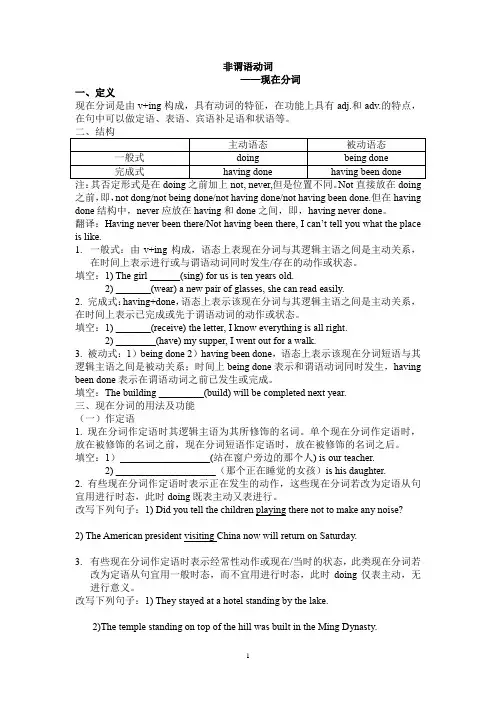
非谓语动词——现在分词一、定义现在分词是由v+ing构成,具有动词的特征,在功能上具有adj.和adv.的特点,在句中可以做定语、表语、宾语补足语和状语等。
之前,即,not dong/not being done/not having done/not having been done.但在having done结构中,never应放在having和done之间,即,having never done。
翻译:Having never been there/Not having been there, I can’t tell you what the place is like.1.一般式:由v+ing构成,语态上表现在分词与其逻辑主语之间是主动关系,在时间上表示进行或与谓语动词同时发生/存在的动作或状态。
填空:1) The girl ______(sing) for us is ten years old.2) _______(wear) a new pair of glasses, she can read easily.2. 完成式:having+done,语态上表示该现在分词与其逻辑主语之间是主动关系,在时间上表示已完成或先于谓语动词的动作或状态。
填空:1) _______(receive) the letter, I know everything is all right.2) ________(have) my supper, I went out for a walk.3. 被动式:1)being done 2)having been done,语态上表示该现在分词短语与其逻辑主语之间是被动关系;时间上being done表示和谓语动词同时发生,having been done表示在谓语动词之前已发生或完成。
填空:The building _________(build) will be completed next year.三、现在分词的用法及功能(一)作定语1. 现在分词作定语时其逻辑主语为其所修饰的名词。

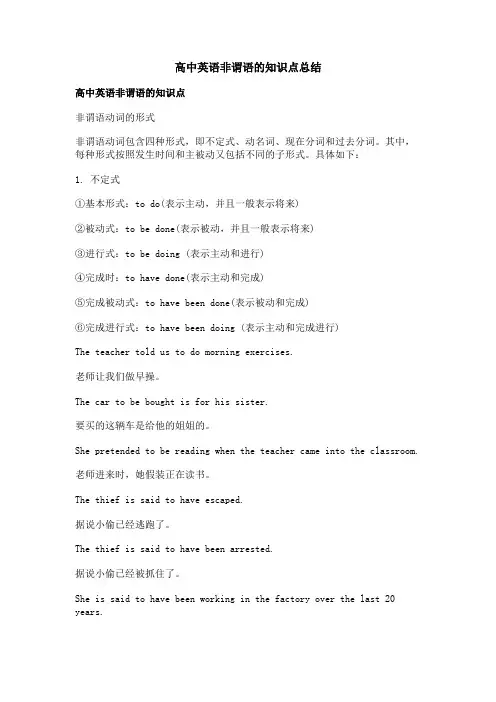
高中英语非谓语的知识点总结高中英语非谓语的知识点非谓语动词的形式非谓语动词包含四种形式,即不定式、动名词、现在分词和过去分词。
其中,每种形式按照发生时间和主被动又包括不同的子形式。
具体如下:1. 不定式①基本形式:to do(表示主动,并且一般表示将来)②被动式:to be done(表示被动,并且一般表示将来)③进行式:to be doing (表示主动和进行)④完成时:to have done(表示主动和完成)⑤完成被动式:to have been done(表示被动和完成)⑥完成进行式:to have been doing (表示主动和完成进行)The teacher told us to do morning exercises.老师让我们做早操。
The car to be bought is for his sister.要买的这辆车是给他的姐姐的。
She pretended to be reading when the teacher came into the classroom.老师进来时,她假装正在读书。
The thief is said to have escaped.据说小偷已经逃跑了。
The thief is said to have been arrested.据说小偷已经被抓住了。
She is said to have been working in the factory over the last 20 years.据说在过去的20年里,她一直在这家工厂工作。
2. 动名词①基本形式:doing (表示主动)②被动式:being done(表示被动)③完成式:having done(表示主动和完成)④完成被动式:having been done(表示被动和完成)Travelling in space by ordinary people will be common in the future.在未来,普通人在太空旅行将会是普遍的事情。

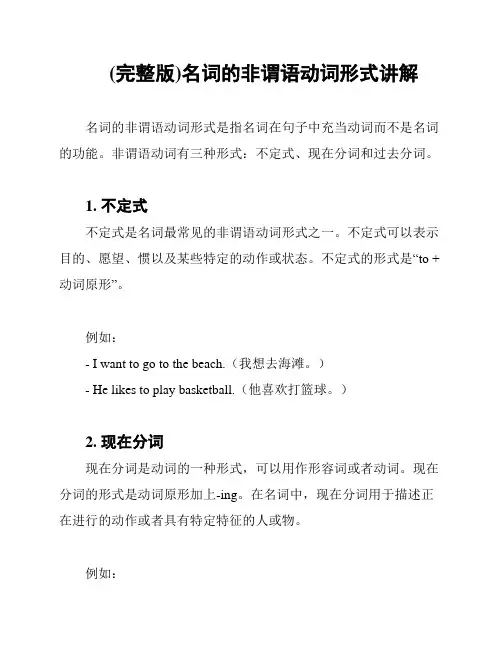
(完整版)名词的非谓语动词形式讲解名词的非谓语动词形式是指名词在句子中充当动词而不是名词的功能。
非谓语动词有三种形式:不定式、现在分词和过去分词。
1. 不定式不定式是名词最常见的非谓语动词形式之一。
不定式可以表示目的、愿望、惯以及某些特定的动作或状态。
不定式的形式是“to + 动词原形”。
例如:- I want to go to the beach.(我想去海滩。
)- He likes to play basketball.(他喜欢打篮球。
)2. 现在分词现在分词是动词的一种形式,可以用作形容词或者动词。
现在分词的形式是动词原形加上-ing。
在名词中,现在分词用于描述正在进行的动作或者具有特定特征的人或物。
例如:- The running man is my brother.(那个跑步的人是我哥哥。
)- The interesting book is on the table.(有趣的书在桌子上。
)3. 过去分词过去分词是动词的一种形式,常用作形容词,表示完成的动作或状态。
过去分词的形式有规律变化和不规则变化。
在名词中,过去分词也用于描述或修饰人或物。
例如:- The broken vase was expensive.(那个破损的花瓶很贵。
)- She is interested in the written article.(她对那篇书面文章很感兴趣。
)综上所述,名词的非谓语动词形式主要包括不定式、现在分词和过去分词。
掌握这些形式的用法和规则可以帮助我们更准确地表达自己的意思,并丰富我们的语言表达能力。
*注意:以上内容仅供参考,具体语法使用请根据具体语境和句子结构进行判断和运用。
*。
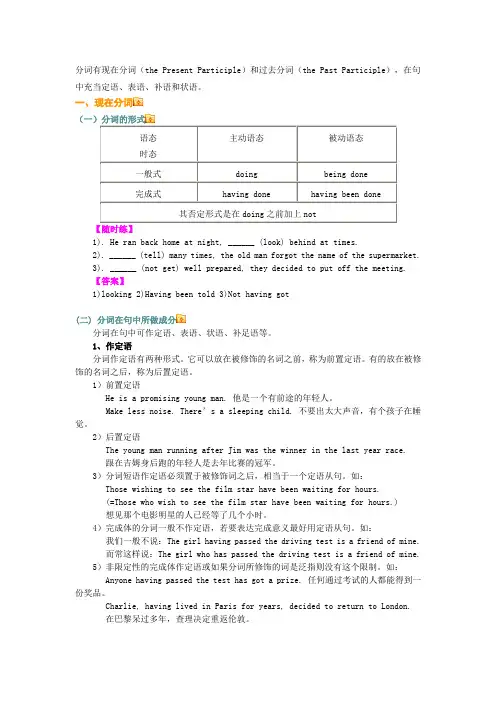
分词有现在分词(the Present Participle)和过去分词(the Past Participle),在句中充当定语、表语、补语和状语。
一、现在分词(一)分词的形式主动语态被动语态语态时态一般式doing being done完成式having done having been done其否定形式是在doing之前加上not【随时练】1). He ran back home at night, ______ (look) behind at times.2). ______ (tell) many times, the old man forgot the name of the supermarket.3). ______ (not get) well prepared, they decided to put off the meeting.【答案】1)looking 2)Having been told 3)Not having got(二) 分词在句中所做成分分词在句中可作定语、表语、状语、补足语等。
1、作定语分词作定语有两种形式。
它可以放在被修饰的名词之前,称为前置定语。
有的放在被修饰的名词之后,称为后置定语。
1)前置定语He is a promising young man. 他是一个有前途的年轻人。
Make less noise. There’s a sleeping child. 不要出太大声音,有个孩子在睡觉。
2)后置定语The young man running after Jim was the winner in the last year race.跟在吉姆身后跑的年轻人是去年比赛的冠军。
3)分词短语作定语必须置于被修饰词之后,相当于一个定语从句。
如:Those wishing to see the film star have been waiting for hours.(=Those who wish to see the film star have been waiting for hours.)想见那个电影明星的人已经等了几个小时。
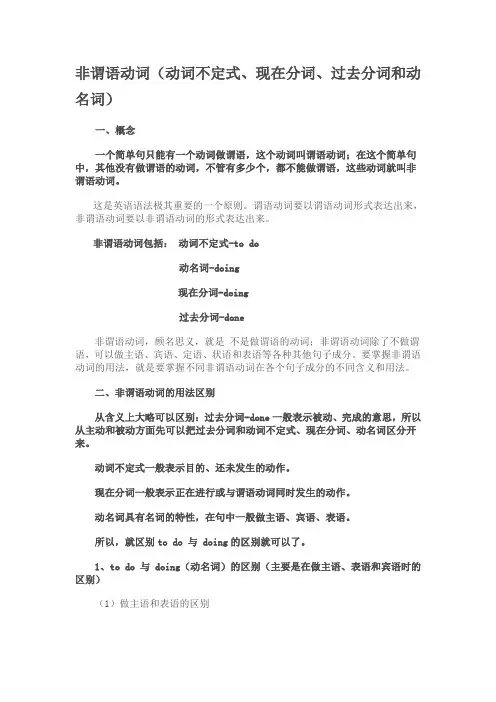
非谓语动词(动词不定式、现在分词、过去分词和动名词)一、概念一个简单句只能有一个动词做谓语,这个动词叫谓语动词;在这个简单句中,其他没有做谓语的动词,不管有多少个,都不能做谓语,这些动词就叫非谓语动词。
这是英语语法极其重要的一个原则。
谓语动词要以谓语动词形式表达出来,非谓语动词要以非谓语动词的形式表达出来。
非谓语动词包括:动词不定式-to do动名词-doing现在分词-doing过去分词-done非谓语动词,顾名思义,就是不是做谓语的动词;非谓语动词除了不做谓语,可以做主语、宾语、定语、状语和表语等各种其他句子成分。
要掌握非谓语动词的用法,就是要掌握不同非谓语动词在各个句子成分的不同含义和用法。
二、非谓语动词的用法区别从含义上大略可以区别:过去分词-done一般表示被动、完成的意思,所以从主动和被动方面先可以把过去分词和动词不定式、现在分词、动名词区分开来。
动词不定式一般表示目的、还未发生的动作。
现在分词一般表示正在进行或与谓语动词同时发生的动作。
动名词具有名词的特性,在句中一般做主语、宾语、表语。
所以,就区别to do与doing的区别就可以了。
1、to do与doing(动名词)的区别(主要是在做主语、表语和宾语时的区别)(1)做主语和表语的区别一般来说,在表示比较抽象的一般行为或者经常性行为时多用动名词;在表示具体的某次动作,特别是将来发生的动作,多作不定式。
做主语:Smoking is prohibited here.此地禁止抽烟。
To invite him to tomorrow party is necessary.邀请他参加明天的聚会是必要的。
做表语:My job is teaching English .我的工作是教英语。
Our task now is to increase food production.我们现在的任务是增加粮食产量。
表语是以下一些词,一般用动名词做真正主语:注意:it是形式主语,动名词是真正主语。
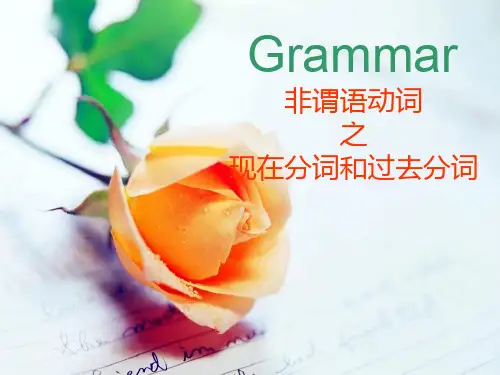
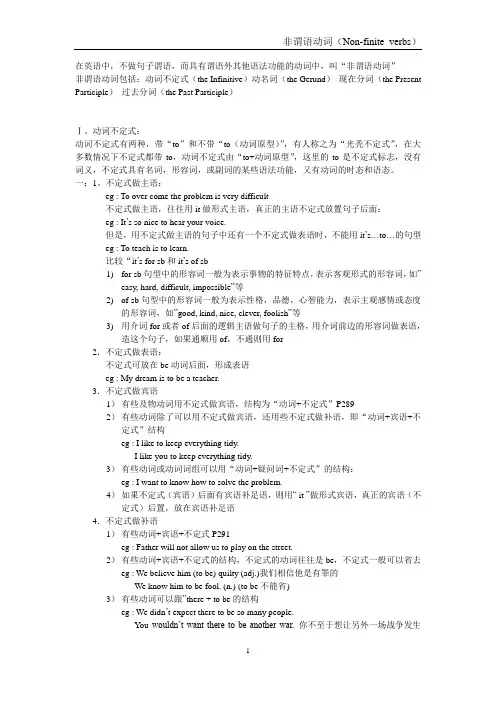
在英语中,不做句子谓语,而具有谓语外其他语法功能的动词中,叫“非谓语动词”非谓语动词包括:动词不定式(the Infinitive)动名词(the Gerund)现在分词(the Present Participle)过去分词(the Past Participle)Ⅰ。
动词不定式:动词不定式有两种,带“to”和不带“to(动词原型)”,有人称之为“光秃不定式”,在大多数情况下不定式都带to,动词不定式由“to+动词原型”,这里的to是不定式标志,没有词义,不定式具有名词,形容词,或副词的某些语法功能,又有动词的时态和语态。
一:1。
不定式做主语:eg : To over come the problem is very difficult不定式做主语,往往用it做形式主语,真正的主语不定式放置句子后面:eg : It‟s so nice to hear your voice.但是,用不定式做主语的句子中还有一个不定式做表语时,不能用it‟s…to…的句型eg : To teach is to learn.比较“it‟s for sb和it‟s of sb1)for sb句型中的形容词一般为表示事物的特征特点,表示客观形式的形容词,如”easy, hard, difficult, impossible”等2)of sb句型中的形容词一般为表示性格,品德,心智能力,表示主观感情或态度的形容词,如”good, kind, nice, clever, foolish”等3)用介词for或者of后面的逻辑主语做句子的主格,用介词前边的形容词做表语,造这个句子,如果通顺用of,不通则用for2.不定式做表语:不定式可放在be动词后面,形成表语eg : My dream is to be a teacher.3.不定式做宾语1)有些及物动词用不定式做宾语,结构为“动词+不定式”P2892)有些动词除了可以用不定式做宾语,还用些不定式做补语,即“动词+宾语+不定式”结构eg : I like to keep everything tidy.I like you to keep everything tidy.3)有些动词或动词词组可以用“动词+疑问词+不定式”的结构:eg : I want to know how to solve the problem.4)如果不定式(宾语)后面有宾语补足语,则用“ it ”做形式宾语,真正的宾语(不定式)后置,放在宾语补足语4.不定式做补语1)有些动词+宾语+不定式P291eg : Father will not allow us to play on the street.2)有些动词+宾语+不定式的结构,不定式的动词往往是be,不定式一般可以省去eg : We believe him (to be) quilty (adj.)我们相信他是有罪的We know him to be fool. (n.) (to be不能省)3)有些动词可以跟”there + to be的结构eg : We didn‟t expect there to be so many people.You wouldn‟t want there to be another war. 你不至于想让另外一场战争发生吧?5.不定式做定语不定式做宾语,通常要放在被修饰的词后,往往表示未发生的动作。
非谓语动词(动词不定式、现在分词、过去分词和动名词)一、概念一个简单句只能有一个动词做谓语,这个动词叫谓语动词;在这个简单句中,其他没有做谓语的动词,不管有多少个,都不能做谓语,这些动词就叫非谓语动词。
这是英语语法极其重要的一个原则。
谓语动词要以谓语动词形式表达出来,非谓语动词要以非谓语动词的形式表达出来。
非谓语动词包括:动词不定式-to do动名词-doing现在分词-doing过去分词-done非谓语动词,顾名思义,就是不是做谓语的动词;非谓语动词除了不做谓语,可以做主语、宾语、定语、状语和表语等各种其他句子成分。
要掌握非谓语动词的用法,就是要掌握不同非谓语动词在各个句子成分的不同含义和用法。
二、非谓语动词的用法区别从含义上大略可以区别:过去分词-done一般表示被动、完成的意思,所以从主动和被动方面先可以把过去分词和动词不定式、现在分词、动名词区分开来。
动词不定式一般表示目的、还未发生的动作。
现在分词一般表示正在进行或与谓语动词同时发生的动作。
动名词具有名词的特性,在句中一般做主语、宾语、表语。
所以,就区别to do与doing的区别就可以了。
1、to do与doing(动名词)的区别(主要是在做主语、表语和宾语时的区别)(1)做主语和表语的区别一般来说,在表示比较抽象的一般行为或者经常性行为时多用动名词;在表示具体的某次动作,特别是将来发生的动作,多作不定式。
做主语:Smoking is prohibited here.此地禁止抽烟。
To invite him to tomorrow party is necessary.邀请他参加明天的聚会是必要的。
做表语:My job is teaching English .我的工作是教英语。
Our task now is to increase food production.我们现在的任务是增加粮食产量。
表语是以下一些词,一般用动名词做真正主语:注意:it是形式主语,动名词是真正主语。
非谓语动词非谓语动词包括不定式(to do)、动名词(-ing)、现在分词(-ing)与过去分词(-ed)。
它们不受主语人称和数的限制,在句子中不能充当谓语,但可以充当句子的其他成分,并且有时态和语态的变化。
动词-ing形式的要点1.-ing的形式2.-ing形式的基本用法…(1)作主语:Seeing is believing. 眼见为实。
(2)作表语:Her job is washing and cooking.(3)作宾语:①作及物动词的宾语。
She likes drawing very much.②作某些短语动词的宾语。
Mary is thinking of going back to New York.③ do+限定词(my, some, any, the等)+v.-ing,表示“做…事”之如do some cleaning打扫卫生do some shopping购物④作介词的宾语:Her sister is good at learning physics.⑤作形容词worth, busy等的宾语:This book is well worth reading.只接动词-ing形式而不接不定式作宾语的动词有:【admit 承认appreciate 感激avoid 避免put off 推迟keep 保持consider 考虑delay/ postpone 耽搁dislike 嫌恶resist 抵制mention 提及enjoy 喜欢escape 避免excuse 原谅practice 练习mind介意fancy想不到feel like 意欲finish 完成risk 冒险include 包括forgive 原谅give up 放弃suggest 建议miss 逃过imagine 想象can’t help 情不自禁involve 需要can’t stand无法忍受understand 理解常见的带介词to的短语:be used to 习惯be related to 与……有关get down to 着手做contribute to 贡献put one’s mind to全神贯注于give rise to 引起be equal to 胜任devote oneself to 献身于lead to 导致be opposed to 反对look forward to 盼望object to 反对stick to 坚持pay attention to 注意(4)作定语:The sleeping child is only five years old.(5)作宾语补足语:We can see steam rising from the wet clothes.可以带有这种复合宾语的动词有see, watch, hear, observe, feel, find, have, keep等。
非谓语动词(现在分词/过去分词的具体用法)Step1:分词的语法意义:(1)分词是非谓语动词,不可以单独作谓语.(2)它具有动词、形容词、副词的特征.A:当它具备动词特征时可有自己的宾语,也可带状语构成分词短语.B:当它具备形容词的特点时,可在句中作定语、宾语补足语和状语,还可以构成独立结构.C:当它具有副词特征时,可在句中作状语,也可构成独立结构.Step2:分类:分词按语法功能可分为现在分词和过去分词两种.Step3:构成:现在分词v+-ing(即v-ing形式);过去分词:V+-ed(即v-ed形式).一,分词作定语的用法.(一)现在分词作定语的用法.特点:(1)单个现在分词作定语时,一般放在所修饰词的后面.(2)若是现在分词短语作定语时,则放在它所修饰词的后面.(3)现在分词作定语,意思表示“正在----的”或“即将-----的”或“令人------的”.(4)与所修饰的名词之间是主动关系,或者表是表示正在进行的动作.E g: The studentraised a confusing question.(表示:令人费解/困惑的)主语及物动词定语宾语译文:这个学生提出一个令人困惑的问题.E g: The retiring teacher walked into the classroom.(表示:即将退休的)定语译文:这位即将退休的老师步入教室.E g: The aging father found it hard to solve this tough problem.(表示:年华正在老去的)定语译文:这位日渐年迈的父亲发现很难解决这个棘手的问题.E g: The man talking to a stranger loudly is our English teacher.(表示:主动和正在进行)现在分词作后置定语译文:正在和一位谋生人大声交谈的那个人是我们的英语老师.(二)过去分词作定语的用法.特点:(1)单个过去分词作定语时,一般放在所修饰词的后面.(2)若是过去分词短语作定语时,则放在它所修饰词的后面.(3)过去分词作定语,意思表示“感到----的”或“受到-----的”.(4)与所修饰的名词之间是被动关系,或者表示:已经完成的动作.E g: The retired soldier passed away last year.(表示:已经退休的或者动作已经完成)定语译文:那个退役的军人上个月去世了.E g: The wounded soldier was sent to the hospital immediately.(表示:受伤的或者动定语经完成).译文:那位受伤的士兵被立刻送往医院.E g: Give me some boiled water to drink.(表示:已经煮开过的或者动作已经完成)定语译文:给我弄点白开水喝.练习:He is sweeping(falling; fallen) leaves in the (falling; fallen) rain.译文:他在雨中扫落叶.二,分词作表语的用法.(一)现在分词作表语的用法.特点:单个现在分词作表语时,多表示主语所具有的特征.一般放在系动词be/become/look/sound/smell/remain/seem/appear等后面.作表语的分词均为形容词.可以译成:“-----------的”.E g: The English speech contest is really exciting.(表示:令人兴奋的)表语译文:这次英语演讲比赛很令人兴奋.E g: The naughty baby is very tiring.(表示:令人累的)表语译文:这个调皮的孩子真是累人.E g: The food smells so inviting.(表示:令人诱惑的)表语译文:这食物闻起来很诱人.E g: This once-in-a-blue-moon experience is really thrilling.(表示:令人刺激的)译文:这次难得的经历真扣人心弦.(二)过去分词作表语的用法.特点:单个过去分词作表语时,多表示主语所处的状态.一般放在系动词be/ become/look/sound/smell/remain/seem/appear等后面.作表语的分词均为形容词.可以译成:“-----------的”.E g: I was bored by her endless bragging.(表示:感到枯燥、厌倦的).译文:她不停地吹嘘,我烦透了.E g: I’m really interested in making a speech in English in public.(表示:感到有趣的)译文:我对在公共场合用英文演讲非常感兴趣.E g: I felt confused about this matter.(表示:感到费解、迷惑的)译文:我对这件事情很费解.总结:并非所有的分词均可当形容词对待.有些分词不能翻译成“--------的”.Killed:不能译成“感到杀的”Killing:不能译成“令人杀的”Writing:不能译成“令人写的”Written:不能译成“感到写的”此类分词,只能置于be动词之后,不可置于连系动词(become/look/sound/smell/remain/seem/appear)等后面,不可视为是形容词,而视为动词的进行时或被动语态.E g: He was murdered last night.(表示:一般过去式的被动语态)译文:他昨晚被谋杀了.E g: I can’t believe you didn’t have a written contract.译文:我简直不敢相信,你居然没有一份书面合同.三,分词作宾语补足语的用法.(一)现在分词作宾语补足语的用法.特点:现在分词作宾语补足语时常用在感官动词和使役动词之后,现在分词一般强调动作正在进行,主动,与物有关.方法:(1)宾补的动词若为及物动词,后面一定接宾语,共同作宾补.(2)宾补的动词为不及物动词,一律用现在分词.(3)宾语与宾补之间为主动关系.(4)宾补的动作在逻辑上是由宾语来完成的.E g: I heard some girls gossiping about you.宾语补足语译文:我听到一些女孩子在说你的闲话.E g: I found him killing cockroaches宾语补足语译文:我发现他正在杀蟑螂.E g: I saw him coming out of the office just now.宾语补足语译文:我刚才看见他正在从办公室出来.(二)过去分词作宾语补足语的用法.特点:现在分词作宾语补足语时常用在感官动词和使役动词之后,过去分词一般强调被动,完成,与人有关.方法:(1)宾补的动词为及物动词,后面不可接宾语(2.)宾语与宾补之间为被动关系,宾补与前面的宾语构成动宾关系.(3)宾补的动作不是由宾语自身完成.E g: I found the cockroaches killed.(过去分词充当宾语补足语)译文:我发现那些蟑螂被人杀了.E g: I had my wallet robbed in the street this morning.(过去分词充当宾语补足语)译文:今天早上在街上我的钱包被人抢了.(三)由介词with引导的复合结构中,分词作宾语补足语的用法.特点:置于句首或句尾,常用来修饰句中的主语,以表示主语所处的状况,通常为大动作附带小动作时,大动作以句子的动词表示,而小动作则使用with复合结构.(1)with +宾语+宾补(过去分词充当).特点:宾语与宾补之间表示被动和完成.E g: He stood there with his arms folded.译文:他双臂交叉站在那里.E g: He sat there with his eyes closed.译文:他双眼闭着坐在那儿.(2)with +宾语+宾补(现在分词充当).特点:宾语与宾补之间表示主动和正在进行.E g: He talked to me with his legs shaking译文:他和我说话时两腿发抖.E g: A: Come on, Please give me some ideas about the project.B: Sorry. With so much work filling my mind, I almost break down.(3)with +宾语+宾补(动词不定式充当).特点:宾语与宾补之间表示将要发生或没有完成.E g: With a lot of difficult problems to settle, the manager felt worried all the time.译文:由于很多的难题没有得到解决,经理一直很担忧.(4)with +宾语+宾补(介词短语充当).特点:表示宾语所处的状态.E g: He talked to me with a pipe in his mouth.译文:他和我说话时嘴里叼着烟斗.四,分词作状语的用法.(一)现在分词作状语的用法.特点:(1)现在分词短语作状语时刻表示原因、方式、伴随、结果、或条件等.此时它的逻辑主语应与句子的主语保持一致.(2)现在分词一般式,若现在分词短语表示的动作与谓语表示的动作同时发生,或者紧接发生,也可在该短语前加上when或while; (3)现在分词的完成时,若现在分词短语表示的动作在谓语表示的动作之前发生.(4)若现在分词短语的逻辑主语(即句子的主语)发出该动作,则就是主动语态.(5)若现在分词短语的逻辑主语(句子的主语)承受了该动作,那么就用它的被动式.E g:We often provide our children with toys, footballs or basketballs,thinking that all children like these things.(现在分词在句中作伴随状语,而且句子的主语是thinking的执行者).译文:我们考虑到孩子们都喜欢这些东西,通常给孩子提供玩具;足球和篮球.E g: Daddy didn’t mind what we were doing, as long as we were together, having fun.(现在分词在句中作伴随状语,而且句子的主语we是having的执行者).译文:只要我们能在一起共享乐趣,爸爸不会介意我们在做什么.E g: The storm left, having caused a lot of damage to this area.(说明:分词的逻辑主语为the storm,故用现在分词表示主动,因为是造成破坏之后离开的,所以用现在完成时态,在句中作时间状语从句)可以改写为:After it had caused a lot of damage to this area, the storm left.E g:Having been separated from other continents for millions of years, Australia has many plants and animals not found in any other country in the world.(说明:separate from 与主句主语有被动的含义,并且先于主句谓语动词,因此用现在分词完成时的被动语态)E g: Oil prices have risen by 32percent since the start of the year, reaching a recor d$57.65 a barrel on April 4.(现在分词在句中作伴随状语)译文:自从今年开始油价已经上涨了32﹪,在4月份达到每桶$57.65这个记录.E g: The manager, having made it clear to us that he didn’t agree with us, left the meeting room.(现在分词的完成时态表示动作发生在主句的动作之前).E g: Whenever he was asked why he was late for class, he would answer careless, always saying the same thing.译文:无论什么时候他被问到为什么他会上课迟到,他总是粗心地答复,说着同样的话.E g:He is a student at OxfordUniversity, studying for a degree in computer science.(现在分词在句中作伴随状语)E g: He was busy writing a story,only stopping once in a while to smoke a cigarette.(现在分词在句中作伴随状语)译文:他那时忙于写一个故事,只是偶尔停下来抽支烟.E g:Having been shown around the Water Cube, we were then taken to see the Bird’s Nest for the 2008 Olympic Games.译文:我们参观了水立方后,又被带去参观了为20XX年奥运会准备的鸟巢.E g: Not realizing that he was in great danger, Eric walked deeper into the forest. (主语Eric与realize 构成主动关系,因此用realizing,v-ing形式前加not表示否定)练习题:1,in the queue for half an hour, the old man suddenly realized he had left the cheque in the car.A: Waiting B: To wait C: Having waited D: To have waited2, in the fields on a March afternoon, he could feel the warmth of spring.A: To walk B: Walking C: Walked D: Having walked3, their hats into the air, the fans of the winning team let out loud shouts of victory.A: To throw B: Thrown C: Throwing B: Being thrown4, We had an anxious couple of weeks for the results of the experiment.A: wait B: to be waiting C: waited D: waiting.5, that she was going off to sleep , I asked if she’s like that little doll on her bed.A: Seeing B: To see C: See D: Seen.6, The wild flowers looked like a soft orange blanketthe desert.A: Covering B: Covered C: Cover D: To cover.(二)过去分词作状语的用法.特点:(1)过去分词短语作状语修饰谓语动词,说明其发生的情况,可以放在句首其强调作用,也可放在句中、句末,它的逻辑主语须与句子的主语保持一致.(2)过去分词一般表示动作已完成,只有一般式.(3)过去分词表示被动和完成E g:Dressed in a white uniform, he looks more like a cook than a doctor.说明:当状语从句的主语和主句主语相一致且谓语包含动词be的某种形式时,可省略从句的主语以及动词be. 恢复原句:When he is dressed in a white uniform, -----------.译文:穿着白色的制服,他看上去更像是个厨师而不像医生.E g: When offered help, one often says “ Thank you.”O r“It’s kind of you.”译文:当被提供了帮助时,人们常说:“谢谢”或“你真好”.E g: Faced with so much trouble, we failed to complete the task on time.说明:be faced with 表示:“面临,面对.”作原因状语.译文:由于面临很多的困难,我们未能按时完成这项工作.E g: Blamed for the breakdown of the school computer network, Alice was in low spirits.(作原因状语).练习题:1,No matter how frequently , the works of Beethoven still attract people all over the world.A: Performed B: Performing C: to be performed D: being performed2,The flowers his friend gave him will die unlessevery day.A: watered B: watering C: water D: to water3, by a greater demand of vegetables , farmers have built more green houses.A: Driven B: Being driven C : To drive D: Having driven4, To learn English well, we should find opportunities to hear Englishas much as we can.A: speak B: speaking C: spoken D: to speak5, It is one of the funniest things on the internet so far this year.A: finding B: being found C: to find D: found(三)分词结构-----动词变化1,若一句中有两个动词同时存在,彼此一定要有连接词相连.E g: He studied very hard but failed the exam.2, 若两个动词没有连接词相连,注意下列变化原则.(1) 若两个动词所代表的动作时同时发生时,第二个动词一定要变成现在分词;若该动词是be动词,变成现在分词being 之后要省略.E g: He sat in the corner reading books.(他一面坐在角落,一面看书,动作同时发生,因此read应该变成现在分词)译文:他坐在角落看书.E g: Don’t sit there doing nothing. Come and help me with this table.译文:别坐那儿无所事事,过来帮助我收拾一下桌子.E g: He came home was tired.第一步:变成:He came home being tired.第二步:变成:He came home tired.(说明:他一面回家,一面感到累,故came与was tired同时发生.由于was是be动词,变成being之后应给予省略)译文:他回到家感到很累.E g: He left young and came back old.译文:他少小离家老大回.E g: We are born equal.译文:我们生而平等.(2)若两个动词所代表的动作并非同时发生,而是有先后次序时,第二个动词就要变成“to+动词原形)形成的不定式短语,作目的状语.E g: He stood up to smoke a cigarette.译文:他站起来抽烟.E g: He rushed here to tell me the story.译文:他赶到这里来告诉我这个故事.(3)若有两个动词有逗号隔开,而无连接词时,就不必考虑动词所代表的动作先后发生的次序,第二个动词一定要变成现在分词.E g: He left home at six in the morning, arriving here about four in the afternoon.译文:他早上6点离开家,约下午4点抵达此地.E g: He ran away quickly, looking as if something terrible had happened.译文:他很快的跑开了,看起来好像发生了什么可怕的事.(四)分词结构-----单句化简法.两个句子在一起,若无连接词相连时,往往第一个句子要化简,变成分词短语.法则如下:(1)两句的主语相同时,被化简的句子的主语要删除,若主语不同时要保留.(2)之后的动词要变成现在分词.(3)若该动词为be动词时,变成现在分词being之后,可给予省略,但亦可不予省略,以强调“因为------”的意思.E g: He has nothing to do, he feels bored.改正:化简第一个句子第一步:删除相同的主语he第二步:其后动词has变成现在分词having.最简化为:Having nothing to do , he feels bored.译文:他没有事情可做,所以觉得无聊.E g: He was sick of studying, he ran away from home.改正:化简第一个句子第一步:删除相同的主语he第二步:其后动词was变成现在分词being,然后给予省略.最简化为:Sick of studying, he ran away from home.译文:他厌倦学习,所以离家出走了.E g: The sun set, the cowboys rode back to the ranch.改正:化简第一个句子第一步:因为两个句子的主语不同,故要保留.第二步:其后动词set变成现在分词setting.最简化为:The sun setting, the cowboys rode back to the ranch.译文:夕阳西下,牛仔们刺马回到牧场(五)使用单句化简法时应注意事项.(1)变成否定分词结构时,not要置于分词前.E g:Not satisfied with result, he decided to try again.译文:他不满意此结果,决定再试一次.(2)句中有助动词do/does/did时,可直接删除.E g: He didn’t intend to see her, he left early.-----Not intending to see her, he left early.译文:他不打算见她,便提前离开了.(3)句中有完成时助动词has /have/had要视为动词而变成现在分词having.E g: He had done the work, he felt very happy.--------having done the work , he left happy.译文:他做完了这个工作,觉得很高兴.E g: I have not seen her for ages, I miss her very much.-------Not having seen her for ages, I miss her very much.译文:好久没有见面了,我非常想念她.(4)主语不同时,所形成的分词短语,成为分词的独立主格结构.所谓分词的独立主格结构,就是独立修饰不同主语的分词结构.在句中只能做状语,表示条件;时间;原因;伴随情况.E g: This being the case, you’d better be more careful.(解释:this being the case原为this is the case,但如此一来,本句与you’d better be more careful 无连接词相连.故将第一个句子化简为分词短语.由于主语不同,故给予保留,之后的动词is变成现在分词being, being the case 独立修饰不同主语this,故称为分词的独立主格结构).译文:这样的话,你最好多加小心.E g: All things considered, I decided to major in business administration.译文:全盘考虑后,我决定主修企业管理.E g: All the work finished, you can go home.译文:所有工作都做完了,你可以回家了.E g: Weather permitting , we are going to have a picnic tomorrow.译文:若天气许可,我们明天就去野餐.(六)分词短语------定语从句化简法.1,在限定性定语从句中、(即关系代词之前无逗号)中,若关系代词作主语时,可化简成分词短语,法则如下:(1)删除关系代词(2)其后动词变成现在分词.(3)若该动词为be动词,变成现在分词being之后,可给予省略.E g: The man who is talking to Mary over there is my father.第一步:将who删除第二步:将who之后的is变成现在分词being第三步:再将being省略.上句可简化成:-----------The man talking to Mary over there is my father.译文:那边那位正在和玛丽说话的男士是我爸爸.2,在非限制性的定语从句中(即关系代词之前有逗号)通常不得化简为分词短语.E g: I like Tom, who is talking to Mary.-------不能变成I like Tom, talking to Mary.3, 不过在非限制性的定语从句结构为“关系代词+be+名词”时,则仍可化简,从而形成同位语.E g: John, who is a good friend of mine, studies hard.------John, a good friend of mine , studies hard.译文:约翰,我的一个好朋友,学习很用功.(七)分词短语------状语从句化简法.Once; when; while; if ;unless; though等六个连接词所引导的状语从句中,若主语与主句中的主语相同时,亦可化简为分词结构,法则与单句化简完全相同.注意:once; if; unless所引导的状语从句若化简为分词短语,多限于“主语+be+分词/形容词”的结构;而when; while; though则不限于此.E g: If I am free, I’ll go with you.-------If free,I’ll go with you.译文:如果有空,我将和你一起去.E g: Though he was seriously injured, he was not at all daunted.-----Though seriously injured, he was not at all daunted.译文:虽然受伤很严重,他一点都不畏惧.E g: Once I am available, I’ll let you know the result.-----O nce available, I’ll let you know the result.译文:一旦我有空,我会告诉你结果的.E g: Once I have money, I’ll buy a new car.------不能转化为Once having money, I’ll buy a new car.(八)少数现在分词可当成介词使用.(1)including 包含/包括=inclusive of ;(2)excluding =exclusive of除外;(3)considering 考虑;(4)regarding关于;(5)concerning=about=on关于E g: Considering his performance, he can be a good teacher.译文:从他的表现来看,他可以当个好老师.E g: He wrote an article regarding environment pollution.译文:他写了一篇有关环境污染的文章.(九)独立分词短语的使用.特点:某些独立分词短语有副词的功能,通常置于句首,修饰整个句子.常见的分词短语有:generally speaking(一般来说); judging from(从----判断); frankly speaking(坦率地说); considering everything(把一切考虑在内); strictly speaking(严格地说); talking of (谈到/谈及); according to(根据); seeing that+从句----------(既然);given that+从句---------(考虑到).E g:Generally speaking, the more expensive the camera, the better its quality.E g:Strictly speaking, he is not good enough.E g: Judging from his appearance, he seems to be rich.E g: Talking of the devil, he will appear.E g:According to John, the fire broke out at ten in the morning.E g:Seeing that you have no time, I’ll have Peter replace you.E g: Given that you had very little help, I think you did very well.(十)与使役动词有关的重要分词短语的句子.1,I started the ball rolling. 我给那件事开个头.2,The news set my heart throbbing.这个消息使我心悸不已3, I am sorry to have kept you waiting.我很抱歉让你久等了.4, I couldn’t make myself understood. 我无法让别人听懂我的话. 5, I had my shoes repaired.我把我的鞋拿去修好了.6, He got a new suit made.他订做了一套西服.7, You should leave it unsaid.你应该别提这件事情.8, I like my eggs half boiled.我喜欢吃煮的半熟的鸡蛋.9, I had my watch stolen.我的表被偷了.。
非谓语动词全总结一.非谓语动词的含义非谓语动词首先是一种动词形式,其次是这种动词形式不能做谓语,综合这两点,我们将其叫做非谓语动词。
二. 非谓语动词的形式非谓语动词包含四种形式,即不定式、动名词、现在分词和过去分词。
具体形式如下:1. 不定式:to do(表示主动,并且一般表示将来)例如:The teacher told us to do morning exercises .老师让我们做早操。
2. 动名词:doing (表示主动)例如:Travelling in space by ordinary people will be common in the future.在未来,普通人在太空旅行将会是普遍的事情。
3. 现在分词:doing (表示主动和进行)例如:He sat there,reading a newspaper.他坐在那里,读着一张报纸。
4. 过去分词:done及物动词的过去分词表示被动或完成;不及物动词的过去分词表示主动或完成。
polluted river 被污染的河流(及物动词pollute和river之间是被动关系,即“河流被污染”)fallen leaves 落叶(不及物动词fall和leaves之间是主动关系,即“叶子落下来”)注意:非谓语动词本身不能表示现在和过去。
非谓语动词表示进行和将来是相对于谓语动作来说的:和谓语动作同时发生表示进行;发生在谓语动作之后表示将来三. 非谓语动词的作用非谓语动词除去不能做谓语之外,其它所有成分都可以做。
具体如下。
1. 不定式:做主语、宾语、表语、定语、状语和补语。
To learn a foreign language is difficult .(作主语)学会一门外语是很难的。
It’s easy to see their aunt.(作真正主语,it做形式主语)很容易见到他们的姑姑。
Tom wanted to have a cup of beer.(作宾语)汤姆想要喝杯啤酒。
分词有现在分词(the Present Participle)和过去分词(the Past Participle),在句中充当定语、表语、补语和状语。
一、现在分词(一)分词的形式主动语态被动语态语态时态一般式doing being done完成式having done having been done其否定形式是在doing之前加上not【随时练】1). He ran back home at night, ______ (look) behind at times.2). ______ (tell) many times, the old man forgot the name of the supermarket.3). ______ (not get) well prepared, they decided to put off the meeting.【答案】1)looking 2)Having been told 3)Not having got(二) 分词在句中所做成分分词在句中可作定语、表语、状语、补足语等。
1、作定语分词作定语有两种形式。
它可以放在被修饰的名词之前,称为前置定语。
有的放在被修饰的名词之后,称为后置定语。
1)前置定语He is a promising young man. 他是一个有前途的年轻人。
Make less noise. There’s a sleeping child. 不要出太大声音,有个孩子在睡觉。
2)后置定语The young man running after Jim was the winner in the last year race.跟在吉姆身后跑的年轻人是去年比赛的冠军。
3)分词短语作定语必须置于被修饰词之后,相当于一个定语从句。
如:Those wishing to see the film star have been waiting for hours.(=Those who wish to see the film star have been waiting for hours.)想见那个电影明星的人已经等了几个小时。
4)完成体的分词一般不作定语,若要表达完成意义最好用定语从句。
如:我们一般不说:The girl having passed the driving test is a friend of mine.而常这样说:The girl who has passed the driving test is a friend of mine.5)非限定性的完成体作定语或如果分词所修饰的词是泛指则没有这个限制。
如:Anyone having passed the test has got a prize. 任何通过考试的人都能得到一份奖品。
Charlie, having lived in Paris for years, decided to return to London.在巴黎呆过多年,查理决定重返伦敦。
2、作表语现在分词作表语表示主语的某种性质或状态。
如:What you said is really inspiring. 你所说的真令从鼓舞。
类似的现在分词还有:surprising, interesting, exciting, boring, disappointing, confusing, embarrassing, ect.3、作宾语补足语I oftentimes hear a girl singing downstairs. 我有时听到楼下有一个小姑娘在唱歌。
现在分词作宾语补足语常在以下情况中出现:1)表示“致使”动词+宾语+现在分词,例如:to set sb thinkingto keep sb waitingto get the clock goingto start sb coughingto have sb. cryingto leave sb. waiting2) 表示“感觉”动词+宾语+现在分词,例如:to smell sth. burningto watch sb swimmingto find sb listening to the recorder这样的动词还有see, hear, feel, notice, observe, look at, listen to等注意:表示“感觉”的动词,既可以用不带to 的不定式作宾语补足语,又可以用现在分词作宾语补足语,但两者有含义上的差别。
现在分词作这些动词的宾语补足语,表示动作的进行。
4、作状语分词在句中作状语,可以表示各种不同的语义内容。
它可以表示时间、原因、让步、结果、方式、条件等。
如:1)表示时间Getting into the train, I fell into sleep. 上了火车,我就睡着了。
表示与主句中谓语动词同时性的现在分词强调时间意义时,分词前可以加上while, when等从属连接词,但as没有这种用法。
如:Don’t talk while having dinner. 吃饭时不要说话。
When crossing the street, do be careful. 过马路时要小心。
2)表示原因表示原因的分词短语一般置于句首。
Having lived in London for years, I almost know every place quite well.在伦敦住过多年,我几乎对每个地方都很熟悉。
3)表示结果Football is played in more than 80 countries, making it a popular sport.80多个国家都踢足球,因此足球成了一种很流行的运动。
4)表示方式I stood by the door, not daring to look up. 我站在门旁,不敢抬头看。
5)表示条件Once deciding which university to attend, you should find out the admission procedure.一旦决定上哪所大学,你必须查明录取程序。
二、过去分词(一)过去分词的基本用法过去分词只有一种形式,也没有主动语态,它所表示的动作是一个被动的或是已完成的动作。
(二)过去分词在句中所作成分过去分词在句中也可用作定语、表语、宾语或状语等成分。
过去分词在句中作某种成分时,其逻辑主语一般为该分词所表示的动作的承受者,如:1、作定语过去分词作定语时,如果这个分词是一个单词,就位于其修饰的名词之前,如果是分词短语,就位于其修饰的名词之后。
如:The stolen painting was found by the police last week.2、作表语过去分词作表语时,表示其逻辑主语所处的状态,其逻辑主语就是句中的主语,如:The window was broken.这个窗户是破的。
注:过去分词作表语时,和动词的被动语态结构相似,但两者表达的意义不同,如:The window was broken by my little brother.这个玻璃杯是被我小弟弟打破的。
作表语用的过去分词在许多词典中已列为形容词,如:crowded, devoted, discouraged, done, dressed, drunk, experienced, frightened, gone, hurt, interested, killed, known, learned, lost, pleased, satisfied, shut, surprised, tired, undressed, worried, astonished, broken, completed, covered等。
3、作宾语补足语过去分词作宾语补足语时,句中的宾语就是其逻辑主语,如:When I opened the door, I found the ground covered by fallen leaves. 打开门我发现,地面被落叶覆盖着。
I had my bike repaired yesterday. 昨天我(找别人)把我的自行车给修了。
注:动词have后的复合宾语中,宾语补足语如为过去分词,常表示该分词所表示的动作是由别人来执行的而不是句中主语自己来执行的。
4、作状语过去分词作状语时,相当于一个状语从句,该结构的逻辑主语一般都是主句的主语,是过去分词所表示意义的逻辑宾语。
为了使作状语的过去分词意义更加明确,常在分词前加when, if, while, though, as等连词,如:Seen from the hill/ When seen from the hill, our town looks beautiful.Given more time/ If given more time, we could have done it better.(we是该结构的逻辑主语,是give的逻辑宾语。
)巩固练习1. The Olympic Games, ______ in 776 B.C, didn’t include women players until 1919.A. first playingB. to be first playedC. first playedD. to be first playing2. European football is played in 80 countries, ______ it the most popular sport in theworld.A. makingB. makesC. madeD. to make3. Little Jim should love ______ to the theatre this evening.A. to be takenB. to takeC. being takenD. taking4.______ a reply, he decided to write again.A. Not receivingB. Receiving notC. Not having receivedD. Having not received5. Most of the artists ______ to the party were from South Africa.A. invitedB. to inviteC. being invitedD. had been invited答案:CAACA。